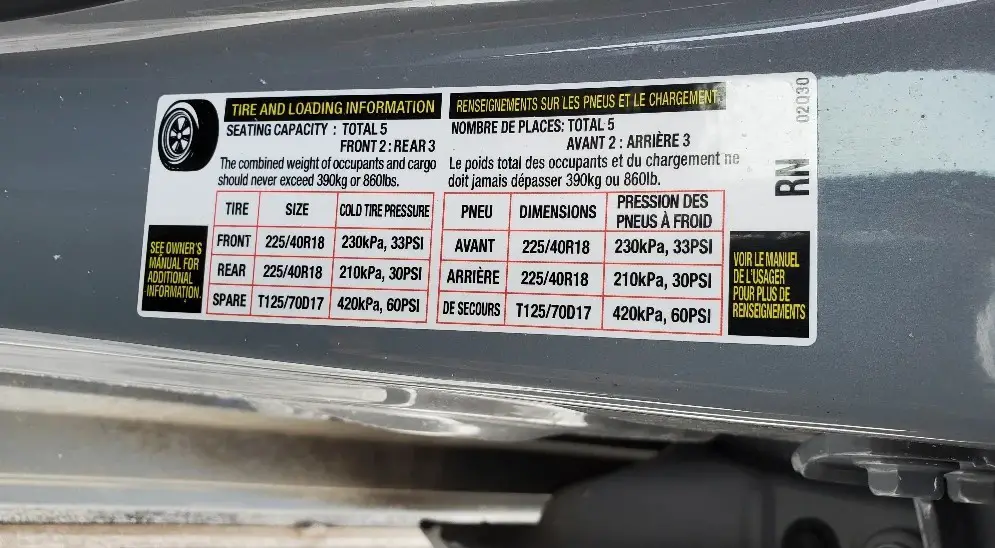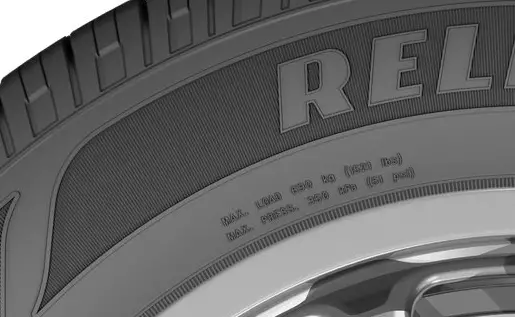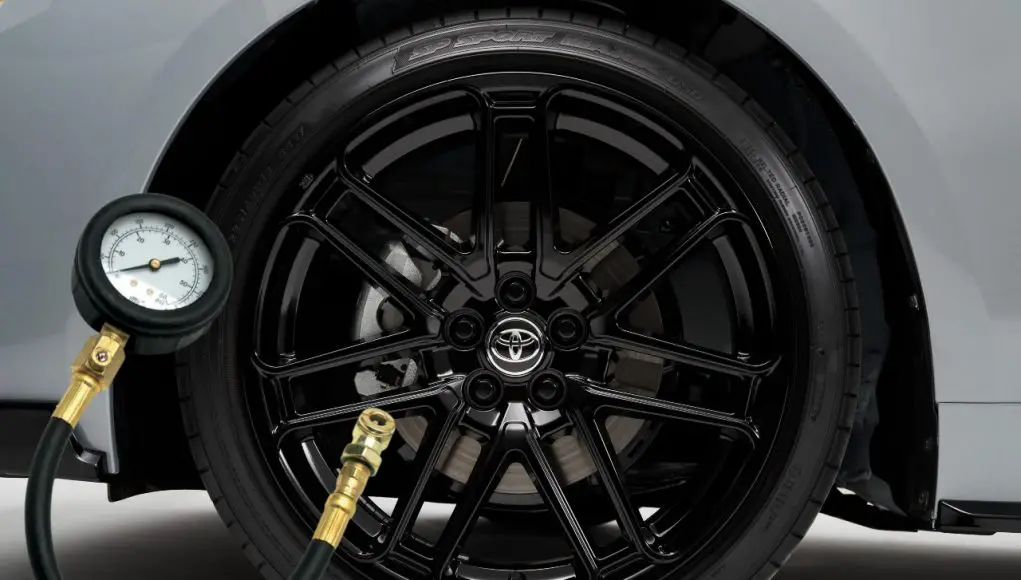The answer is yes, and here’s why with a big asterisk.
Now that gas is expensive again, people are doing everything they can to save fuel, and that includes keeping up with things they can control like maintenance.
One of those maintenance items that’s practically free to monitor and has a drastic effect on mpg is tire pressures.
According to FuelEconomy.Gov, “Under-inflated tires can lower gas mileage by about .2 percent for every 1 psi drop in the average pressure of all tires.”
That means a Honda Civic measuring 28 PSI all around from the recommended 33 PSI may drop as much as a 1 MPG just because they didn’t have enough air in their tires.
At the very least, you should pump up your tires to the recommended setting found on your inner door jamb.
Here’s what one looks like on a newer 2022 Toyota Corolla.

But, what happens if I pump up my PSI and overinflate my tires, will I get better gas mileage?
Let’s dig into that.
Why 40 PSI?
Overinflating tires for better fuel efficiency was born both from people with too much time on their hands and from the hyper-miling community, a dedicated group of car enthusiasts who own hybrids or cars with small engines that mod their cars to prioritize MPG above all else.
Hypermilers understand the importance of rolling resistance and how the lack thereof spells better overall MPG.
According to Continental Tires, “Rolling resistance can be defined as the amount of energy a tire uses over a defined distance.
The less rolling resistance a tire has, the easier it is to propel down the road. A more efficient car equals improved MPGs.
Push a wheelbarrow with a flat tire, and you’ll notice how much harder it is for you.
That recommended PSI setting on your door panel? It’s a compromise determined by your car’s engineers.
This PSI setting is for normal driving for your tire size, giving car owners the best compromise of handling, safety, wear, and mileage for both tire and fuel efficiency.
What hypermilers found out is that they can go above and beyond the recommended PSI setting resulting in drastically better MPG reporting little side effects, often a slightly harsher ride with little to no effect on stopping distance and handling.
With every PSI above what’s recommended, these hyper-milers noticed gradual savings in fuel used. Gains generally leveled out around 40 PSI, or roughly 15 percent above normal. Additional MPG gains above that is not worth the increased ride harshness and possible negative affects to handling and increased stopping distance..
“I went from the dealer 35/33 to the 42/40 and saw immediate mpg increase of 1-2 mpg,” says PriusChat forum member JDCollinsS5.
Is inflating your tires to 40 PSI or 15% above your recommended pressures safe?
According to Tire Rack, “An overinflated tire is stiff and unyielding, and the size of its footprint in contact with the road is reduced.”
A reduced footprint or a smaller contact patch results in decreased stopping performance.
An overinflated tire also wears out faster and, if you end up replacing your tires too soon because of increased wear, that will negate any fuel savings.
But, can you inflate your tires up to a point above what’s recommended on your door panel that will not have a negligible effect on your tire’s performance and safety?
Yes, but you will have to do some homework.
You will need to buy a big piece of chalk and carry out The Chalk Test to determine if your overinflated tires still have a sufficient contact patch.
Long story short, inflate your tires up to the amount you want to test, then, draw a big, thick line across the width of the tire. Drive forward one car length and see what kind of chalk imprint is left. A properly inflated tire will press the chalk line evenly across the ground. Seeing only the center of the line means over inflation, and seeing only the sides of the line means under inflation.
InterCo Tire Corporation has a complete write-up how to perform the Chalk Method linked here.
If your car passes the chalk test with 40 PSI (or 15% above normal,) you can confidently say it’s safe enough to test on the road. Pay attention to how your car reacts with slightly higher tire pressures.
You may even notice improved handling.
“Higher inflation pressures usually provide an improvement in steering response and cornering stability up to a point. This is why participants who use street tires in auto crosses, track events and road races run higher than normal inflation pressures,” TireRack goes on to say.
Most importantly, you’ll want to record your mileage and fuel used between fill-ups with your old and new PSI settings to accurately gauge if, indeed, you’re ACTUALLY saving fuel.
But won’t over-inflating tires cause tire blowouts?
The phrase “over-inflating your tires” conjures up images of cartoonlike over-exaggeration where your tires are ticking time bombs, ready to blow at the slightest bump.
What exactly IS dangerous levels of over-inflation?
First, tire manufacturers spell out what the recommended max cold tire pressure is on the tire itself. Here’s the max pressure on a cheap American-made Goodyear Reliant tire, it’s a lot higher than you think. Yup, 61 PSI. Goodyear determined if you’re carrying the max load (a fully loaded car and cargo) their tire can safely be inflated up to 61 PSI to handle that extra weight, no problem.
Max tire pressures range between 44-65 psi.

That’s nowhere near the bursting pressure of a tire, which is generally around 200 PSI .
“…over-inflation almost never causes tire failure, ” says William Woehrle of Tire Forensics Investigation.
Keeping in mind what the manufacturer’s max pressure setting is and how much air will actually cause an explosion, adding extra air up to 40 PSI isn’t going to cause much harm.
And, it’s not over inflation that causes tire blowouts, it’s the exact opposite.
TireRack spells it out for us.
“While one might assume that all blowouts are caused by too much internal pressure bursting a weak spot in the tire, the main reason for them is just the opposite. Most blowouts are caused by too little air pressure allowing the tire to flex beyond its elastic limits until it overheats to the point where the rubber loses its bond to the internal fabric and steel cord reinforcement.”
So, when you read blog posts claiming, “Overinflating your tires is just stupid and increases the risk of a blow out” you’ll know they don’t actually know what they’re talking about.
Conclusion
There’s a strong correlation between increasing your tire’s PSI up to 15% over the recommended setting and increase in average MPG.
It’s important you do your homework to determine if overinflating your car’s tires to 40 PSI or 15 percent above normal is right for you. That means researching what PSIs other car owners with the same car as you are running and their experience and MPGs. A good place to ask is on car specific facebook groups (Toyota Camry Owners, Ford F-150 enthusiasts, etc.) and online forums like PriusChat.com or the equivalent. (For example, Honda Ridgeline owners have Piloteers.org.)
You also want to make sure your tires are in tip-top shape to begin with. That means taking care of alignment issues, swapping out old and cracked tires for fresh ones, and making sure you’re rotating them per your owner’s manual recommended rotation intervals.
If you don’t want to do any legwork and overinflating tires for better MPG sounds too risky, pumping up your tires 1-2 PSI above the recommended setting is probably right for you. At best, it’s slightly above normal and takes into account gradually losing air over time.
For example, let’s take that 2022 Toyota Corolla’s recommended tire pressures above.
- Recommended Settings- 33 front/ 30 rear
- Lazy settings- 34 front/ 31 rear
- 15 percent over-inflation increase for better MPG- 38 front/ 35 rear
Overinflating tires above what you usually set them to is a cheap and effective way to maximize your car’s fuel efficiency potential.
Like all things, finding a happy medium above what’s recommended and going too far is key.





[…] Overinflate your tires: Overinflating your tires is just stupid and increases the risk of a blow out. […]